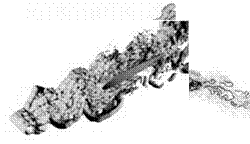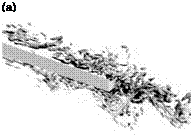Basic Mechanisms – External Flows
Major noise generating mechanisms from external wall-bounded flows are introduced and described shortly in this section. Phenomena associated with thermal conductivity are discarded so that the analysis is focused on mechanical aspects. Complementary developments should be considered for internal flows and/or combustion problems, as discussed in chapter 1. The different ways the mechanisms can be simulated or modeled for the sake of noise predictions in the far-field will be addressed in subsequent chapters.
The first fundamental principle to be retained from everyday life experience is that vortex dynamics makes sound. This implies two major mechanisms. First, sound is generated as free vortices interact mutually: this occurs in any turbulent mixing region such as a free jet or a turbulent boundary layer over a smooth boundary. Secondly, sound is generated as vortices interact directly with a geometrical singularity of a solid surface, such as a sharp edge, a corner, an excrescence or any accident. The second mechanism is much more efficient, as easily understood for instance by putting a knife blade in the jet of a pressure-cooker valve and hearing the difference in radiated sound level.
Examples shown is the chapter are just specific declinations of the same process. They are mostly related to a broadband noise signature since a
![]()
 |
 |
(d)
Figure 1. Generic turbulent flows responsible for broadband noise generation, illustrated by instantaneous 3D patterns (a, c, d) and 2D vortical trace (b). (a): vortex-
shedding from a cylinder; (b): trailing-edge scattering of a turbulent boundary layer; (c): combined trailing-edge scattering and vortex shedding; (d): combined vortex-shedding and turbulence impingement on an airfoil. From Moon et al (2010) (a), Wang et al (2009) (b), Chang et al (2006) (c) and Jacob et al (2002).
turbulent flow is the origin of the sound generating process. Sound can also be radiated when a solid surface is moving through the air in an accelerated, periodic motion, as shown in section 5.4. This specific mechanism is typically involved in the tonal noise of rotating blades, not addressed in this book.
Typical unsteady vortical flows attached to solid surfaces and generating broadband or narrow-band noise at relatively moderate-to-large Reynolds numbers (in the sense that the flow regime is definitely turbulent) are illustrated in Fig. 1-a-to-d from Moon et al (2010), Wang et al (2009), Chang et al (2006) and Jacob et al (2002). All pictures are deduced from validated Large-Eddy Simulations (LES), either compressible or incompressible. They only illustrate the vortex dynamics responsible for sound production, not
the sound itself. The vortex-shedding mechanism (Fig. 1-a) produces the Aeolian tones heard when the wind is blowing on mechanical structures. The noise produced by trailing-edge scattering (Fig. 1-b) is important for all rotating-blade technologies, especially for wind turbines. Both may be produced together in the case of blunted trailing-edges (Fig. 1-c). The two – body configuration of Fig. 1-d is a first step toward the investigation of more complicated ones, such as the high-lift devices of an aircraft wing. In this case, the impingement of the vortical patterns shed from the first body onto the second one is generally much noisier than the vortex shedding itself. The first three cases are mechanisms of what is called the self-noise of a solid surface in a flow. The fourth one illustrates the turbulence-impingement noise of an airfoil. Both that noise and trailing-edge noise will be addressed specifically in chapter 5.
Going into the details, the faster the inertia variation in a vortical flow is, the more efficient is the acoustic dissipation. This makes sound production much stronger in the vicinity of singular points on a solid surface, such as leading or trailing edges of blades, slots or bumps on surfaces, and so on. For vortex-shedding noise, the dominant unsteady vortical motion takes place downstream in the very near wake. The rapid inertia variation is precisely in the formation of the vortices. As a result the source domain is the immediate vicinity of the cylinder. Trailing-edge noise is due to the rapid re-arrangement of boundary-layer turbulence as it is convected past the edge; this is why the efficient source region is a limited area around the trailing edge. The same holds in configuration (c) for both incriminated mechanisms. In case (d) the dominant source region is the more or less extended vicinity of the airfoil leading edge.
Previous examples refer to bodies of limited extent with respect to the acoustic or aerodynamic length scales. But boundary-layer flows developing on the walls of elongated bodies also generate sound. It is well accepted that a developed turbulent boundary layer over an extended and smooth surface such as a rigid flat plate is not an efficient sound generator because of its dominant quadrupole nature, as pointed out by Goldstein (1976). In contrast the aerodynamic sound is much higher if the surface exhibits a geometrical singularity. Therefore cavities, slits, excrescences or steps appear as localized sources of noise. This will be discussed in section 2.5.
Pictures of Fig. 1 together with aforementioned arguments stress that the dominant sources are quite localized around the surface edges and that vortex dynamics farther away in the wake is a minor contribution. With respect to a distant observer the unsteady flows act as equivalent moving sources radiating in the surrounding medium. The prediction methodology subsequently developed is in two steps; one is the description of the equivalent sources, the other one is the description of the propagation itself. Both are detailed in next sections.











